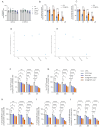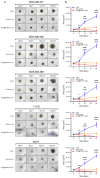Novel CD44-Targeted Albumin Nanoparticles: An Innovative Approach to Improve Breast Cancer Treatment
- PMID: 39408889
- PMCID: PMC11477043
- DOI: 10.3390/ijms251910560
Novel CD44-Targeted Albumin Nanoparticles: An Innovative Approach to Improve Breast Cancer Treatment
Abstract
This study introduces novel CD44-targeted and redox-responsive nanoparticles (FNPs), proposed as doxorubicin (DOX) delivery devices for breast cancer. A cationized and redox-responsive Human Serum Albumin derivative was synthesized by conjugating Human Serum Albumin with cystamine moieties and then ionically complexing it with HA. The suitability of FNPs for cancer therapy was assessed through physicochemical measurements of size distribution (mean diameter of 240 nm), shape, and zeta potential (15.4 mV). Nanoparticles possessed high DOX loading efficiency (90%) and were able to trigger the drug release under redox conditions of the tumor environment (55% release after 2 h incubation). The use of the carrier increased the cytotoxic effect of DOX by targeting the CD44 protein. It was shown that, upon loading, the cytotoxic effect of DOX was enhanced in relation to CD44 protein expression in both 2D and 3D models. DOX@FNPs significantly decrease cellular metabolism by reducing both oxygen consumption and extracellular acidification rates. Moreover, they decrease the expression of proteins involved in the oxidative phosphorylation pathway, consequently reducing cellular viability and motility, as well as breast cancer stem cells and spheroid formation, compared to free DOX. This new formulation could become pioneering in reducing chemoresistance phenomena and increasing the specificity of DOX in breast cancer patients.
Keywords: breast cancer; cationized albumin; hyaluronic acid; ionic nanoparticles; vectorization.
Conflict of interest statement
The authors declare no conflicts of interest.
Figures





Similar articles
-
Facile strategy by hyaluronic acid functional carbon dot-doxorubicin nanoparticles for CD44 targeted drug delivery and enhanced breast cancer therapy.Int J Pharm. 2020 Mar 30;578:119122. doi: 10.1016/j.ijpharm.2020.119122. Epub 2020 Feb 5. Int J Pharm. 2020. PMID: 32035259
-
GE11 peptide modified and reduction-responsive hyaluronic acid-based nanoparticles induced higher efficacy of doxorubicin for breast carcinoma therapy.Int J Nanomedicine. 2016 Oct 7;11:5125-5147. doi: 10.2147/IJN.S113469. eCollection 2016. Int J Nanomedicine. 2016. PMID: 27785019 Free PMC article.
-
Reduction-sensitive CD44 receptor-targeted hyaluronic acid derivative micelles for doxorubicin delivery.Int J Nanomedicine. 2018 Jul 26;13:4361-4378. doi: 10.2147/IJN.S165359. eCollection 2018. Int J Nanomedicine. 2018. PMID: 30100720 Free PMC article.
-
CD44-specific nanoparticles for redox-triggered reactive oxygen species production and doxorubicin release.Acta Biomater. 2016 Apr 15;35:280-92. doi: 10.1016/j.actbio.2016.02.005. Epub 2016 Feb 4. Acta Biomater. 2016. PMID: 26853764
-
Hyaluronic acid-based nanoplatforms for Doxorubicin: A review of stimuli-responsive carriers, co-delivery and resistance suppression.Carbohydr Polym. 2021 Nov 15;272:118491. doi: 10.1016/j.carbpol.2021.118491. Epub 2021 Jul 27. Carbohydr Polym. 2021. PMID: 34420747 Review.
References
-
- Chen S.M., Cao Z., Prettner K., Kuhn M., Yang J.T., Jiao L.R., Wang Z.R., Li W.M., Geldsetzer P., Baernighausen T., et al. Estimates and Projections of the Global Economic Cost of 29 Cancers in 204 Countries and Territories from 2020 to 2050. JAMA Oncol. 2023;9:465–472. doi: 10.1001/jamaoncol.2022.7826. - DOI - PMC - PubMed
MeSH terms
Substances
LinkOut - more resources
Full Text Sources
Medical
Miscellaneous

